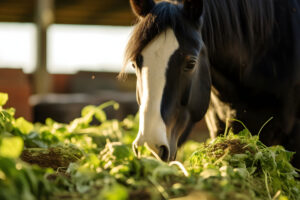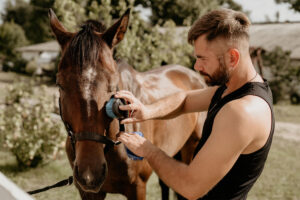
Maintaining a horse’s well-being is of utmost importance to every responsible equestrian. In order to ensure their physical and mental health, it is essential to understand the difference between stable vices and healthy coping mechanisms. By recognizing these behaviors and implementing appropriate strategies, horse owners can provide a conducive environment for their equine companions. In this article, we will explore the distinction between stable vices and coping mechanisms, along with practical approaches to promoting positive behaviors.
Understanding Stable Vices: Stable vices refer to repetitive, abnormal behaviors exhibited by horses when they are confined to stalls or subjected to stressful situations. These vices can be detrimental to the horse’s health, leading to physical injuries and emotional distress. Common examples of stable vices include cribbing, weaving, stall walking, and pawing. Such behaviors often develop as a result of boredom, frustration, or anxiety.
Coping Mechanisms for Horses: On the other hand, coping mechanisms are adaptive strategies employed by horses to deal with challenging situations. These mechanisms enable horses to manage stress, maintain emotional balance, and prevent the development of harmful behaviors. Healthy coping strategies include social interaction with other horses, engaging in natural behaviors such as grazing and playing, and participating in regular exercise and mental stimulation.
Promoting Positive Behaviors: As horse owners, it is crucial to create an environment that minimizes stress and encourages positive behaviors. Here are some effective approaches to promote healthy coping mechanisms:
- Sufficient Turnout Time: Horses are social animals that require ample time to interact with their herd mates. Regular turnout in a spacious paddock or pasture allows them to engage in natural behaviors, reducing the likelihood of developing stable vices.
- Mental Stimulation: Providing mental stimulation is essential to keep horses mentally engaged and prevent boredom. This can be achieved through the use of toys, treat puzzles, or by varying their training routines to challenge their minds.
- Environmental Enrichment: Creating a stimulating environment within the stable can also help divert the horse’s attention from negative behaviors. Incorporating visual or auditory stimuli, such as mirrors or soothing music, can help reduce stress and anxiety.
- Regular Exercise: Regular exercise is not only beneficial for physical health but also plays a vital role in managing stress. By incorporating a consistent exercise routine, horses can release pent-up energy, reduce anxiety, and promote overall well-being.
- Social Interaction: Horses are social creatures that thrive in the presence of their herd. Whenever possible, allow horses to have visual and physical contact with other equines, either through shared fences or during supervised group turnout.
Conclusion: By understanding the distinction between stable vices and healthy coping mechanisms, horse owners can create an environment that supports their horse’s mental and physical well-being. Implementing strategies such as sufficient turnout time, mental stimulation, environmental enrichment, regular exercise, and social interaction can help mitigate the development of stable vices and promote positive behaviors. Remember, a content and happy horse is a cornerstone of a fulfilling equestrian partnership.






